Comparative Study of Ferroelectric and Piezoelectric Properties of BNT-BKT-BT Ceramics near the Phase Transition Zone
Abstract
:1. Introduction
2. Materials and Methods
2.1. Sample Preparation
2.2. Sample Characterization
2.2.1. Density, Structural, and Microstructural Characteristics
2.2.2. Dielectric, Ferroelectric, and Piezoelectric Properties
3. Results and Discussion
3.1. Structural Analysis
3.1.1. Characteristics of Samples by X-ray Diffraction
3.1.2. Raman Spectroscopy
3.2. Microstructure
3.3. Electromechanical Analysis
3.3.1. Dielectric Constant
3.3.2. Ferroelectric Hysteresis
3.3.3. Piezoelectric Characteristics
4. Conclusions
Acknowledgments
Author Contributions
Conflicts of Interest
References
- Bowen, C.R.; Kim, H.A.; Weaver, P.M.; Dunn, S. Piezoelectric and ferroelectric materials and structures for energy harvesting applications. Energy Environ. Sci. 2014, 7, 25–44. [Google Scholar] [CrossRef] [Green Version]
- Priya, S. Advances in energy harvesting using low profile piezoelectric transducers. J. Electroceramics 2007, 19, 165–182. [Google Scholar] [CrossRef]
- Roedel, J.; Webber, K.G.; Dittmer, R.; Jo, W.; Kimura, M.; Damjanovic, D. Transferring lead-free piezoelectric ceramics into application. J. Eur. Ceram. Soc. 2015, 35, 1659–1681. [Google Scholar] [CrossRef]
- Scott, J.F. Applications of Modern Ferroelectrics. Science 2007, 315, 954–959. [Google Scholar] [CrossRef] [PubMed]
- Esquivel-Gaon, M.; Anguissola, S.; Garry, D.; Gallegos-Melgar, A.D.C.; Saldana, J.M.; Dawson, K.A.; De Vizcaya-Ruiz, A.; Del Razo, L.M. Bismuth-based nanoparticles as the environmentally friendly replacement for lead-based piezoelectrics. RSC Adv. 2015, 5, 27295–27304. [Google Scholar] [CrossRef]
- Härdtl, K.H.; Rau, H. PbO vapour pressure in the Pb(Ti1−x)O3 system. Solid State Commun. 1969, 7, 41–45. [Google Scholar] [CrossRef]
- Wolny, W.W. European approach to development of new environmentally sustainable electroceramics. Ceram. Int. 2004, 30, 1079–1083. [Google Scholar] [CrossRef]
- Takenaka, T.; Nagata, H.; Hiruma, Y. Current developments and prospective of lead-free piezoelectric ceramics. Jpn. J. Appl. Phys. 2008, 47, 3787–3801. [Google Scholar] [CrossRef]
- Roedel, J.; Jo, W.; Seifert, K.T.P.; Anton, E.M.; Granzow, T.; Damjanovic, D. Perspective on the development of lead-free piezoceramics. J. Am. Ceram Soc. 2009, 92, 1153–1177. [Google Scholar] [CrossRef]
- Panda, P.K. Review: Environmental friendly lead-free piezoelectric materials. J. Mater. Sci. 2009, 44, 5049–5062. [Google Scholar] [CrossRef]
- Aksel, E.; Jones, J.L. Advances in lead-free piezoelectric materials for sensors and actuators. Sensors 2010, 10, 1935–1954. [Google Scholar] [CrossRef] [PubMed]
- Priya, S.; Nahm, S. Lead-Free Piezoelectrics; Springer: New York, NY, USA, 2013. [Google Scholar]
- Coondoo, I.; Panwar, N.; Kholkin, A. Lead-free piezoelectrics: Current status and perspectives. J. Adv. Dielectr. 2013, 3, 1330002. [Google Scholar] [CrossRef]
- Smolenskii, G.A.; Isupov, V.A.; Agranovskaya, A.I.; Krainik, N.N. New Ferroelectrics of Complex Composition. Sov. Phys. Solid State 1961, 2, 2651–2654. [Google Scholar]
- Nagata, H.; Yoshida, M.; Makiuchi, Y.; Takenaka, T. Large piezoelectric constant and high curie temperature of lead-free piezoelectric ceramic ternary system based on bismuth sodium titanate-bismuth potassium titanate-barium titanate near the morphotropic phase boundary. Jpn. J. Appl. Phys. 2003, 42, 7401–7403. [Google Scholar] [CrossRef]
- Buhrer, C.F. Some properties of bismuth perovskites. J. Chem. Phys. 1962, 36, 798–803. [Google Scholar] [CrossRef]
- Gorfman, S.; Thomas, P.A. Evidence for a non-rhombohedral average structure in the lead-free piezoelectric material Na0.5Bi0.5TiO3. J. Appl. Crystallogr. 2010, 43, 1409–1414. [Google Scholar] [CrossRef]
- Aksel, E.; Forrester, J.S.; Jones, J.L.; Thomas, P.A.; Page, K.; Suchomel, M.R. Monoclinic crystal structure of polycrystalline Na0.5Bi0.5TiO3. Appl. Phys. Lett. 2011, 98, 3–6. [Google Scholar] [CrossRef]
- Chu, B.J.; Chen, D.R.; Li, G.R.; Yin, Q.R. Electrical properties of Na1/2Bi1/2TiO3-BaTiO3 ceramics. J. Eur. Ceram. Soc. 2002, 22, 2115–2121. [Google Scholar] [CrossRef]
- Hiruma, Y.; Aoyagi, R.; Nagata, H.; Takenaka, T. Ferroelectric and piezoelectric properties of (Bi1/2K1/2)TiO3 ceramics. Jpn. J. Appl. Phys. 2005, 44, 5040. [Google Scholar] [CrossRef]
- Nagata, H.; Saitoh, M.; Hiruma, Y.; Takenaka, T. Fabrication and piezoelectric properties of textured (Bi1/2K1/2)TiO3 ferroelectric ceramics. Jpn. J. Appl. Phys. 2010, 49, 09MD08. [Google Scholar] [CrossRef]
- Karaki, T.; Yan, K.; Adachi, M. Barium titanate piezoelectric ceramics manufactured by two-step sintering. Jpn. J. Appl. Phys. 2007, 46, 7035–7038. [Google Scholar] [CrossRef]
- Arlt, G.; Hennings, D.; De With, G. Dielectric properties of fine-grained barium titanate ceramics. J. Appl. Phys. 1985, 58, 1619–1625. [Google Scholar] [CrossRef]
- Acharya, S.K.; Kim, T.-M.; Hyung, J.-H.; Ahn, B.-G.; Lee, S.-K. Ferroelectric and piezoelectric properties of lead-free Bi0.5Na0.5TiO3–Bi0.5K0.5TiO3–BaTiO3-thin films near the morphotropic phase boundary. J. Alloys Compd. 2014, 586, 549–554. [Google Scholar] [CrossRef]
- Li, Y.; Chen, W.; Xu, Q.; Zhou, J.; Gu, X.; Fang, S. Electromechanical and dielectric properties of Na0.5Bi0.5TiO3–K0.5Bi0.5TiO3–BaTiO3 lead-free ceramics. Mater. Chem. Phys. 2005, 94, 328–332. [Google Scholar] [CrossRef]
- Shrout, T.R.; Zhang, S.J. Lead-free piezoelectric ceramics: Alternatives for PZT? J. Electroceramics 2007, 19, 111–124. [Google Scholar] [CrossRef]
- Takenaka, T.; Nagata, H. Current status and prospects of lead-free piezoelectric ceramics. J. Eur. Ceram. Soc. 2005, 25, 2693–2700. [Google Scholar] [CrossRef]
- Yang, Z.; Liu, B.; Wei, L.; Hou, Y. Structure and electrical properties of (1−x)Bi0.5Na0.5TiO3−xBi0.5K0.5TiO3 ceramics near morphotropic phase boundary. Mater. Res. Bull. 2008, 43, 81–89. [Google Scholar] [CrossRef]
- Li, Y.; Chen, W.; Xu, Q.; Zhou, J.; Gu, X. Piezoelectric and ferroelectric properties of Na0.5Bi0.5TiO3–K0.5Bi0.5TiO3–BaTiO3 piezoelectric ceramics. Mater Lett. 2005, 59, 1361–1364. [Google Scholar] [CrossRef]
- Otoničar, M.; Škapin, S.D.; Spreitzer, M.; Suvorov, D. Compositional range and electrical properties of the morphotropic phase boundary in the Na0.5Bi0.5TiO3-K0.5Bi0.5TiO3 system. J. Eur. Ceram. Soc. 2010, 30, 971–979. [Google Scholar] [CrossRef]
- Sasaki, A.; Chiba, T.; Mamiya, Y.; Otsuki, E. Dielectric and piezoelectric properties of (Bi0.5Na0.5)TiO3 –(Bi0.5K0.5)TiO3 Systems. Jpn. J. Appl. Phys. 1999, 38, 5564–5567. [Google Scholar] [CrossRef]
- Zhao, W.; Zhou, H.P.; Yan, Y.K.; Liu, D. Morphotropic Phase Boundary Study of the BNT-BKT Lead-Free Piezoelectric Ceramics. Key Eng. Mater. 2008, 368–372, 1908–1910. [Google Scholar] [CrossRef]
- Zhao, T.-L.; Guo, Z.-L.; Wang, C.-M. The effects of Na/K ratio on the electrical properties of sodium-potassium bismuth titanate Na0.5Bi4.5Ti4O15-K0.5Bi4.5Ti4O15. J. Am. Ceram. Soc. 2012, 95, 1062–1067. [Google Scholar] [CrossRef]
- Zhang, S.-T.; Yang, B.; Cao, W. The temperature-dependent electrical properties of Bi0.5Na0.5TiO3–BaTiO3–Bi0.5K0.5TiO3 near the morphotropic phase boundary. Acta Mater. 2012, 60, 469–475. [Google Scholar] [CrossRef]
- Wang, X.X.; Tang, X.G.; Chan, H.L.W. Electromechanical and ferroelectric properties of (Bi1/2Na1/2)TiO3–(Bi1/2K1/2)TiO3–BaTiO3 lead-free piezoelectric ceramics. Appl. Phys. Lett. 2004, 85, 91–93. [Google Scholar] [CrossRef]
- Trelcat, J.-F.; Courtois, C.; Rguiti, M.; Leriche, A.; Duvigneaud, P.H.; Segato, T. Morphotropic phase boundary in the BNT–BT–BKT system. Ceram Int. 2012, 38, 2823–2827. [Google Scholar] [CrossRef]
- Quiroga, D.A.B.; Albornoz Diaz, J.C.C.; Venet, M.; Rodrigues, A.D.G.; Florêncio, O.; da Silva, P.S., Jr. Evolution of crystalline phases and morphotropic phase boundary of the (Bi,Na)TiO3-(Bi,K)TiO3-BaTiO3 lead-free ceramic system. J. Alloys Compd. 2017, 691, 498–503. [Google Scholar] [CrossRef]
- Kreisel, J.; Glazer, A.; Bouvier, P.; Lucazeau, G. High-pressure Raman study of a relaxor ferroelectric: The Na0.5Bi0.5TiO3 perovskite. Phys. Rev. B 2001, 63, 174106. [Google Scholar] [CrossRef]
- Kreisel, J.; Glazer, A.M.; Jones, G.; Thomas, P.A.; Abello, L.; Lucazeau, G. An x-ray diffraction and Raman spectroscopy investigation of A-site substituted perovskite compounds: the (Na1−xKx)0.5Bi0.5TiO3(0 ≤ x ≤ 1) solid solution. J. Phys. Condens. Matter 2000, 12, 3267–3280. [Google Scholar] [CrossRef]
- Rout, D.; Moon, K.-S.; Rao, V.S.; Kang, S.-J.L. Study of the morphotropic phase boundary in the lead-free Na1/2Bi1/2TiO3-BaTiO3 system by Raman spectroscopy. J. Ceram. Soc. Jpn. 2009, 117, 797–800. [Google Scholar] [CrossRef]
- Suchanicz, J.; Jankowska-Sumara, I.; Kruzina, T.V. Raman and infrared spectroscopy of Na0.5Bi0.5TiO3–BaTiO3 ceramics. J. Electroceramics 2011, 27, 45–50. [Google Scholar] [CrossRef]
- Rout, D.; Moon, K.S.; Park, J.; Kang, S.J.L. High-temperature X-ray diffraction and Raman scattering studies of Ba-doped (Na0.5Bi0.5)TiO3 Pb-free piezoceramics. Curr. Appl. Phys. 2013, 13, 1988–1994. [Google Scholar] [CrossRef]
- Lidjici, H.; Lagoun, B.; Berrahal, M.; Rguitti, M.; Hentatti, M.A.; Khemakhem, H. XRD, Raman and electrical studies on the (1−x)(Na0.5Bi0.5)TiO3−xBaTiO3 lead free ceramics. J. Alloys Compd. 2015, 618, 643–648. [Google Scholar] [CrossRef]
- Ramajo, L.; Camargo, J.; Rubio-Marcos, F.; Castro, M. Influences of secondary phases on ferroelectric properties of Bi(Na,K)TiO3 ceramics. Ceram. Int. 2015, 41, 5380–5386. [Google Scholar] [CrossRef]
- Parija, B.; Badapanda, T.; Rout, S.K.; Cavalcante, L.S.; Panigrahi, S.; Longo, E.; Batista, N.C.; Sinha, T.P. Morphotropic phase boundary and electrical properties of 1−x[Bi0.5Na0.5]TiO3−xBa[Zr0.25Ti0.75]O3 lead-free piezoelectric ceramics. Ceram. Int. 2013, 39, 4877–4886. [Google Scholar] [CrossRef]
- Yin, Q.; Zhu, B.; Zeng, H. Microstructure, Property and Processing of Functional Ceramics; Springer: New York, NY, USA, 2003. [Google Scholar]
- Wang, X.X.; Choy, S.H.; Tang, X.G.; Chan, H.L.W. Dielectric behavior and microstructure of (Bi1/2Na1/2)TiO3–(Bi1/2K1/2)TiO3–BaTiO3 lead-free piezoelectric ceramics. J. Appl. Phys. 2005, 97, 104101. [Google Scholar] [CrossRef]
- Uchino, K. Ferroelectric Devices; CRC Press: Boca Raton, FL, USA, 2009. [Google Scholar]
- Ibrahim, A.A.M.A.; Murgan, R.; Rahman, M.; Osman, J. Morphotropic Phase Boundary in Ferroelectric Materials. In Ferroelectrics-Physical Effects; InTech: Rijeka, Croatia, 2011. [Google Scholar]
- Shieh, J.; Wu, K.C.; Chen, C.S. Switching characteristics of MPB compositions of (Bi0.5Na0.5)TiO3-BaTiO3-(Bi0.5K0.5)TiO3 lead-free ferroelectric ceramics. Acta Mater. 2007, 55, 3081–3087. [Google Scholar] [CrossRef]
- Frey, M.H.; Xu, Z.; Han, P.; Payne, D.A. The role of interfaces on an apparent grain size effect on the dielectric properties for ferroelectric barium titanate ceramics. Ferroelectrics 1998, 206, 337–353. [Google Scholar] [CrossRef]
- Cao, W.; Randall, C.A. Grain size and domain size relations in bulk ceramic ferroelectric materials. J. Phys. Chem. Solids 1996, 57, 1499–1505. [Google Scholar] [CrossRef]
- Arlt, G. The influence of microstructure on the properties of ferroelectric ceramics. Ferroelectrics 1995, 104, 217–227. [Google Scholar] [CrossRef]
- Martirena, H.T.; Burfoot, J.C. Grain-size effects on properties of some ferroelectric ceramics. J. Phys. C Solid State Phys. 1974, 7, 3182–3192. [Google Scholar] [CrossRef]
- Randall, C.A.; Kim, N.; Kucera, J.-P.; Cao, W.; Shrout, T.R. Intrinsic and extrinsic size effects in fine-grained morphotropic-phase-boundary lead zirconate titanate ceramics. J. Am. Ceram. Soc. 1998, 81, 677–688. [Google Scholar] [CrossRef]
- Kainz, T.; Naderer, M.; Schütz, D.; Fruhwirth, O.; Mautner, F.A.; Reichmann, K. Solid state synthesis and sintering of solid solutions of BNT-xBKT. J. Eur. Ceram. Soc. 2014, 34, 3685–3697. [Google Scholar] [CrossRef]
- Cao, W.; Cross, L.E. Theoretical model for the morphotropic phase boundary in zirconate-lead titanate solid solution. Phys. Rev. B 1993, 47, 4825–4830. [Google Scholar] [CrossRef]
- König, J.; Spreitzer, M.; Jančar, B.; Suvorov, D.; Samardžija, Z.; Popovič, A. The thermal decomposition of K0.5Bi0.5TiO3 ceramics. J. Eur. Ceram. Soc. 2009, 29, 1695–1701. [Google Scholar] [CrossRef]
- Naderer, M.; Schütz, D.; Kainz, T.; Reichmann, K.; Mittermayr, F. The formation of secondary phases in Bi0.5Na0.375K0.125TiO3 ceramics. J. Eur. Ceram. Soc. 2012, 32, 2399–2404. [Google Scholar] [CrossRef]
- Zhang, Y.R.; Li, J.F.; Zhang, B.P. Enhancing electrical properties in NBT-KBT lead-free piezoelectric ceramics by optimizing sintering temperature. J. Am. Ceram. Soc. 2008, 91, 2716–2719. [Google Scholar] [CrossRef]
- Bernardo, M.S.; Jardiel, T.; Peiteado, M.; Caballero, A.C.; Villegas, M. Reaction pathways in the solid state synthesis of multiferroic BiFeO3. J. Eur. Ceram. Soc. 2011, 31, 3047–3053. [Google Scholar] [CrossRef] [Green Version]
- Hagiwara, M.; Fujihara, S. Grain-size-dependent spontaneous relaxor-to-ferroelectric phase transition in (Bi1/2K1/2)TiO3 ceramics. Appl. Phys. Lett. 2015, 107, 012903. [Google Scholar] [CrossRef]
- Hagiwara, M.; Ehara, Y.; Novak, N.; Khansur, N.H.; Ayrikyan, A.; Webber, K.G.; Fujihara, S. Relaxor-ferroelectric crossover in (Bi1/2K1/2)TiO3: Origin of the spontaneous phase transition and the effect of an applied external field. Phys. Rev. B 2017, 96, 014103. [Google Scholar] [CrossRef]
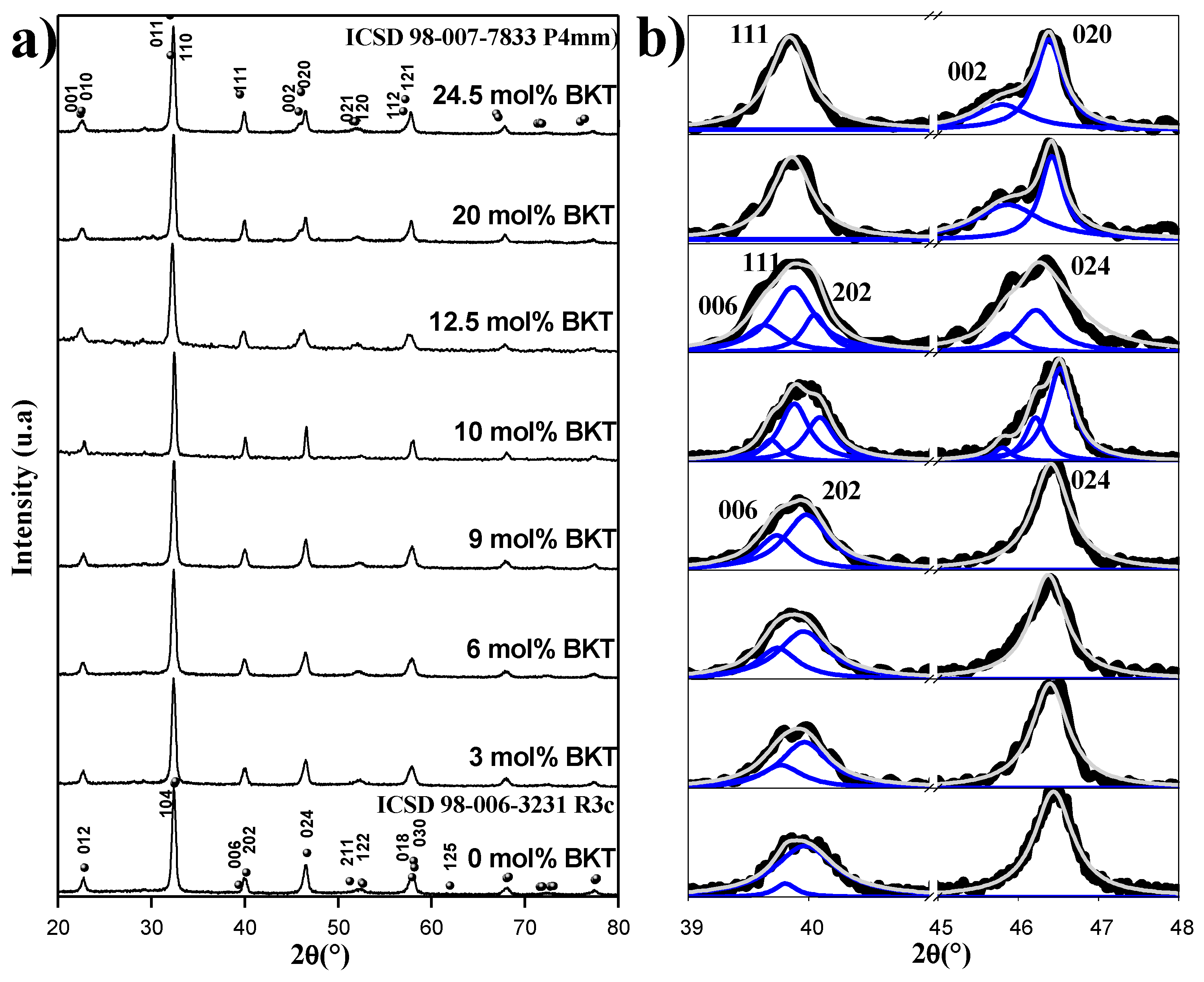
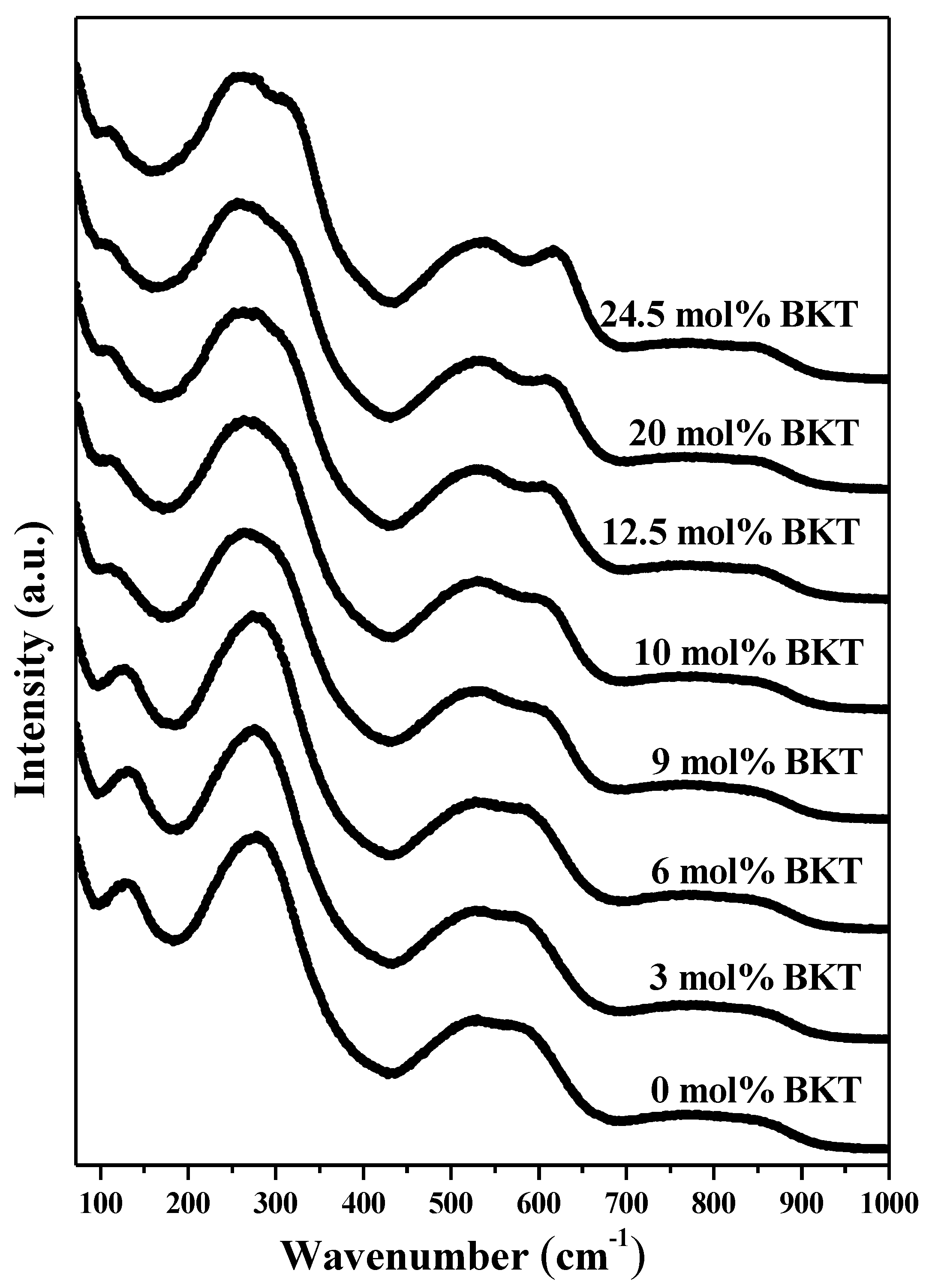
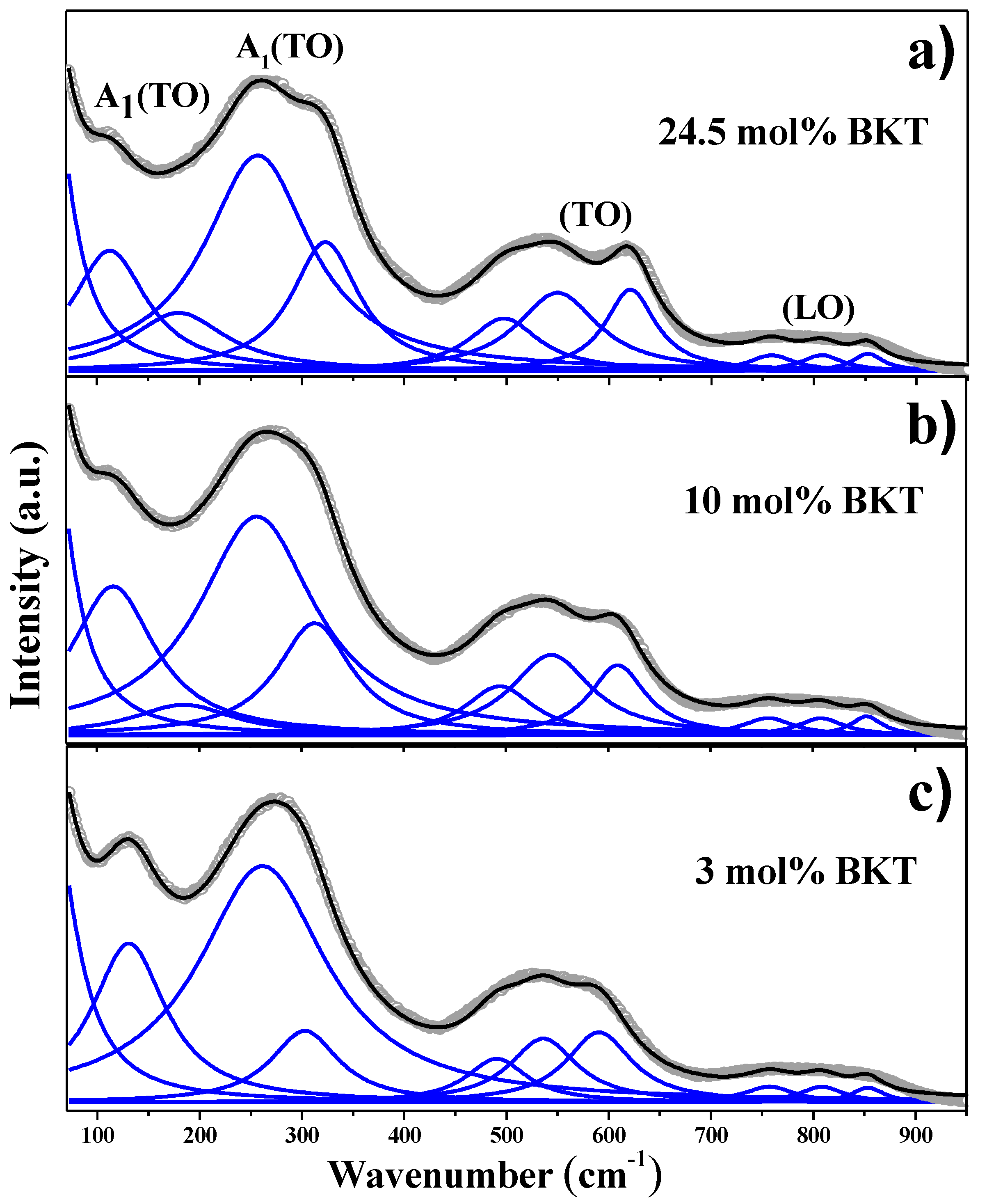
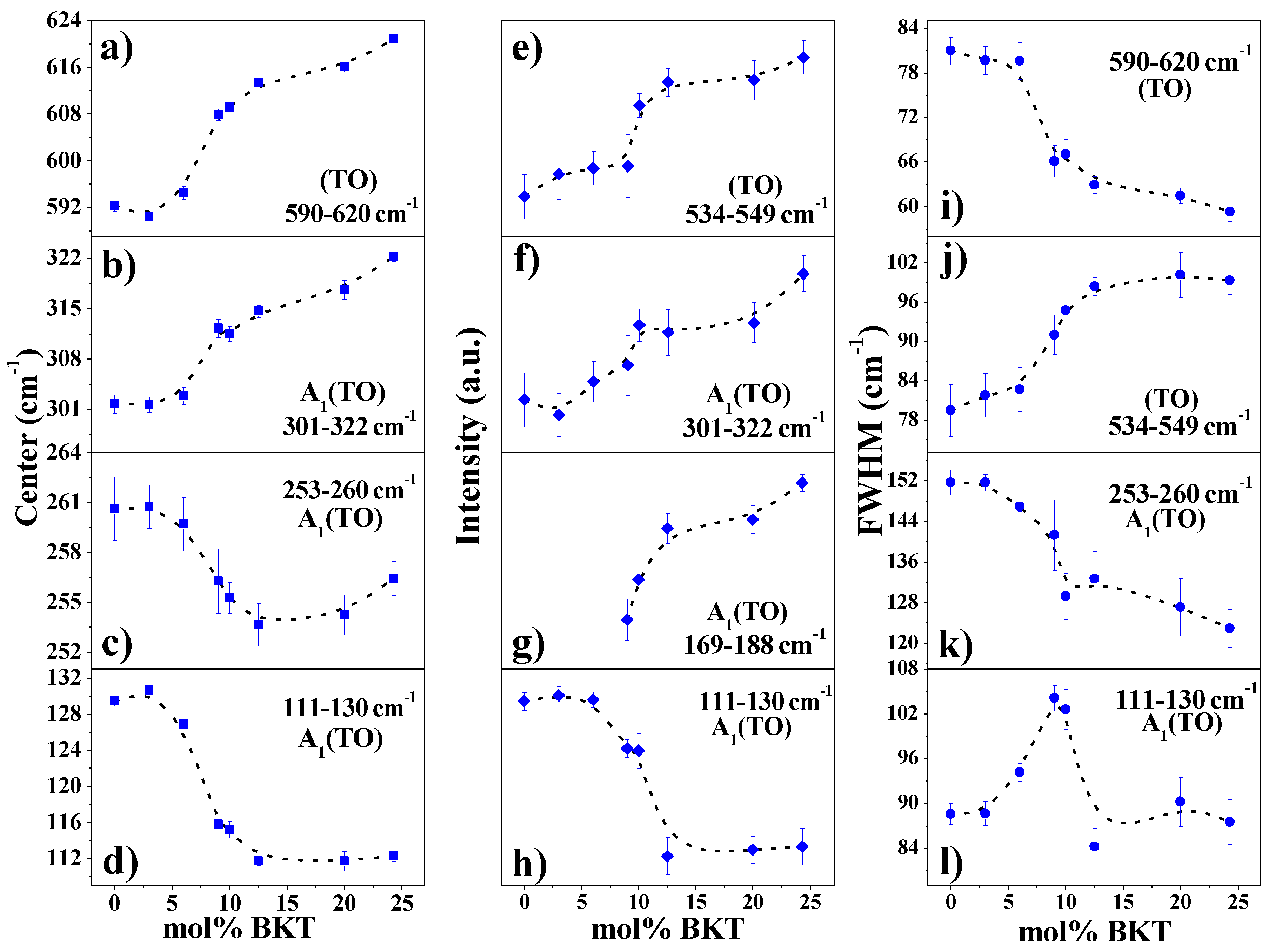
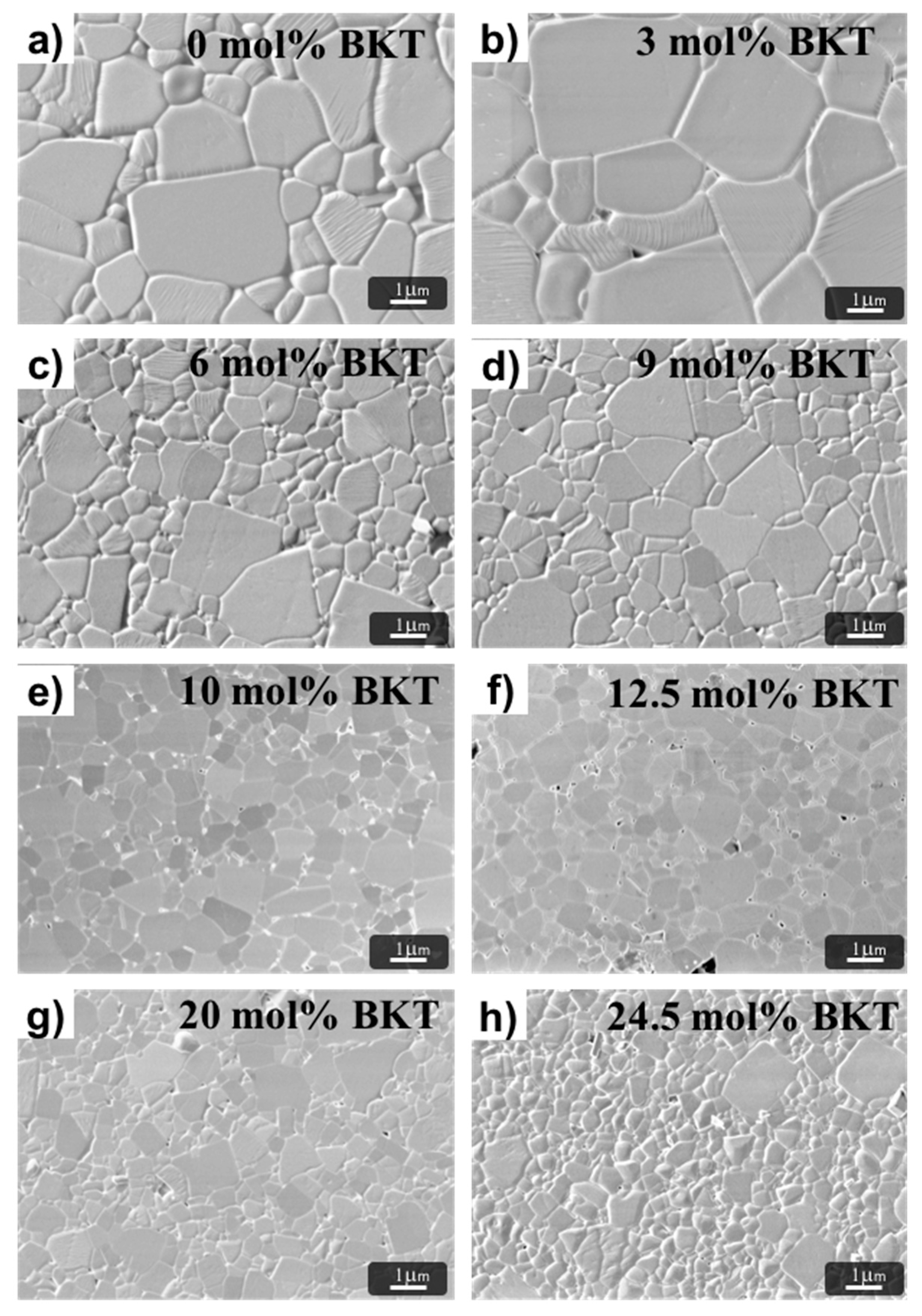
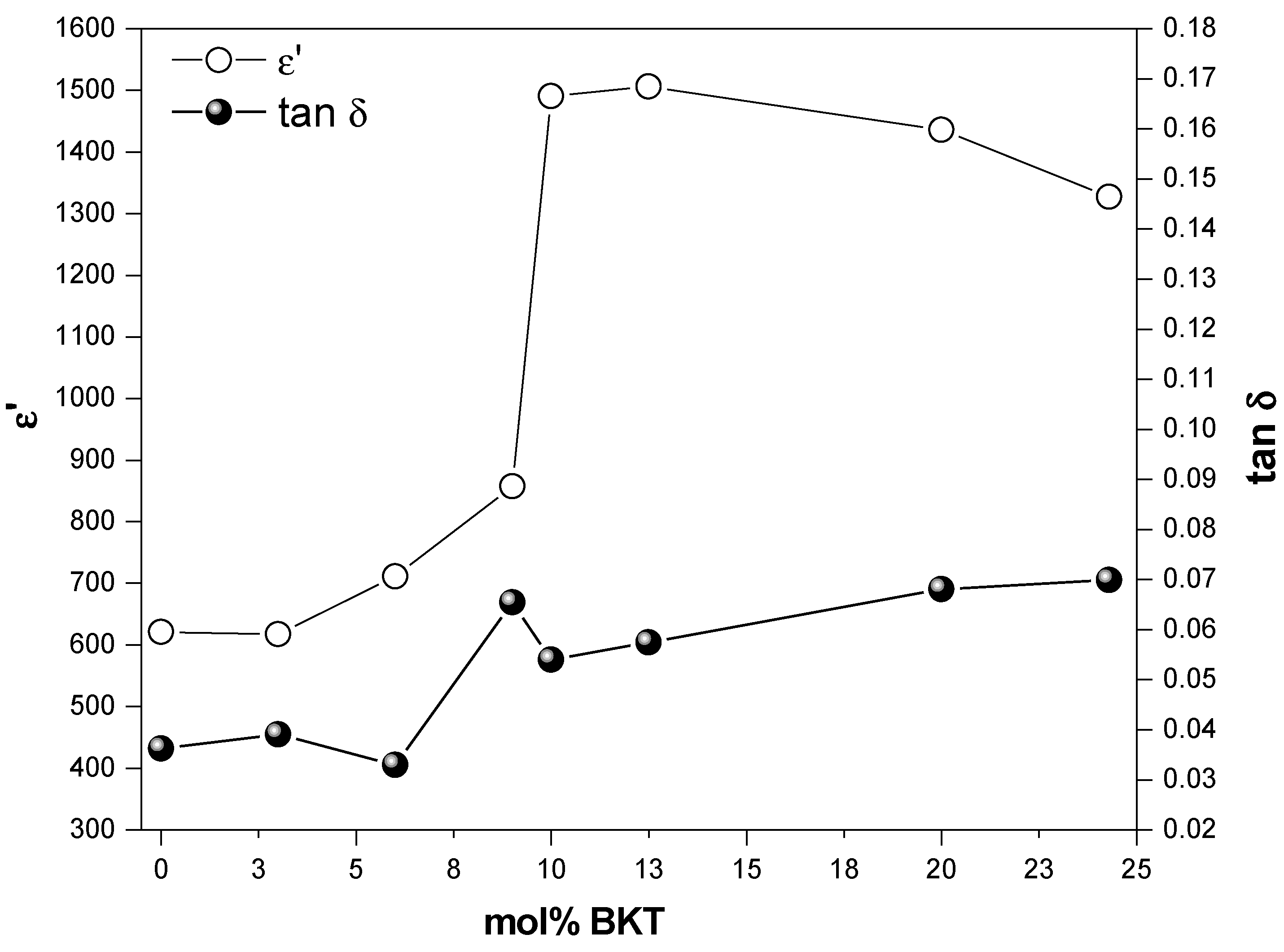
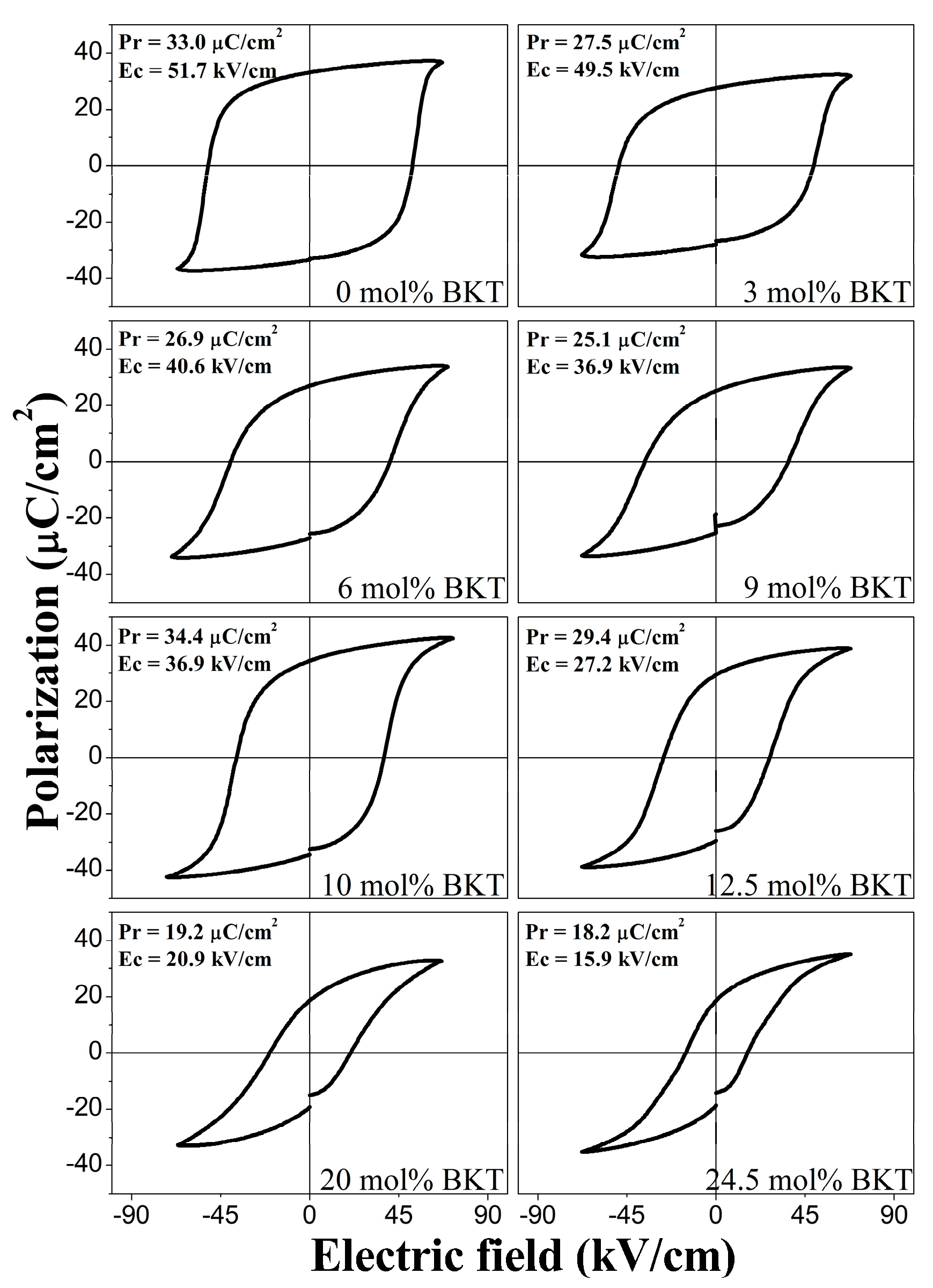
| Sample (mol % BKT) | Average Grain Size (µm) | SD | Mode (µm) | Interquartile Range (µm) |
|---|---|---|---|---|
| 0 | 1.86 | 1.15 | 1.10 | 0.98 |
| 3.0 | 2.43 | 1.33 | 1.66 | 1.48 |
| 6.0 | 1.14 | 0.61 | 0.80 | 0.68 |
| 9.0 | 0.91 | 0.44 | 0.68 | 0.60 |
| 10.0 | 0.73 | 0.31 | 0.56 | 0.50 |
| 12.5 | 0.66 | 0.33 | 0.47 | 0.45 |
| 20.0 | 0.63 | 0.28 | 0.51 | 0.45 |
| 24.5 | 0.55 | 0.25 | 0.41 | 0.37 |
| Sample (mol % BKT) | 𝜀′ | tanδ | Pr (µC/cm2) | Ec (kV/cm) | Qmr | kp | Qme | kt | d33 (pC/N) |
|---|---|---|---|---|---|---|---|---|---|
| 0 | 621.1 | 0.04 | 33 | 51.7 | 143.0 | 0.15 | 35.2 | 0.45 | 72 |
| 3 | 617.8 | 0.04 | 27.5 | 49.5 | 141.7 | 0.16 | 31.1 | 0.43 | 73 |
| 6 | 711.8 | 0.03 | 26.9 | 40.6 | 144.8 | 0.19 | 43.4 | 0.41 | 79 |
| 9 | 858.0 | 0.06 | 25.1 | 36.9 | 113.5 | 0.18 | 18.1 | 0.41 | 66 |
| 10 | 1490.5 | 0.05 | 34.4 | 36.9 | 60.1 | 0.24 | 12.5 | 0.52 | 109 |
| 12.5 | 1505.8 | 0.06 | 29.4 | 27.2 | 40.0 | 0.24 | 10.2 | 0.50 | 126 |
| 20.0 | 1435.8 | 0.07 | 19.2 | 20.9 | 32.0 | 0.16 | 28.5 | 0.33 | 71 |
| 24.3 | 1327.4 | 0.07 | 18.2 | 15.9 | 29.4 | 0.16 | 28.9 | 0.32 | 70 |
© 2018 by the authors. Licensee MDPI, Basel, Switzerland. This article is an open access article distributed under the terms and conditions of the Creative Commons Attribution (CC BY) license (http://creativecommons.org/licenses/by/4.0/).
Share and Cite
Fernandez-Benavides, D.A.; Gutierrez-Perez, A.I.; Benitez-Castro, A.M.; Ayala-Ayala, M.T.; Moreno-Murguia, B.; Muñoz-Saldaña, J. Comparative Study of Ferroelectric and Piezoelectric Properties of BNT-BKT-BT Ceramics near the Phase Transition Zone. Materials 2018, 11, 361. https://doi.org/10.3390/ma11030361
Fernandez-Benavides DA, Gutierrez-Perez AI, Benitez-Castro AM, Ayala-Ayala MT, Moreno-Murguia B, Muñoz-Saldaña J. Comparative Study of Ferroelectric and Piezoelectric Properties of BNT-BKT-BT Ceramics near the Phase Transition Zone. Materials. 2018; 11(3):361. https://doi.org/10.3390/ma11030361
Chicago/Turabian StyleFernandez-Benavides, David Andres, Aixa Ibeth Gutierrez-Perez, Angelica Maria Benitez-Castro, Maria Teresa Ayala-Ayala, Barbara Moreno-Murguia, and Juan Muñoz-Saldaña. 2018. "Comparative Study of Ferroelectric and Piezoelectric Properties of BNT-BKT-BT Ceramics near the Phase Transition Zone" Materials 11, no. 3: 361. https://doi.org/10.3390/ma11030361





